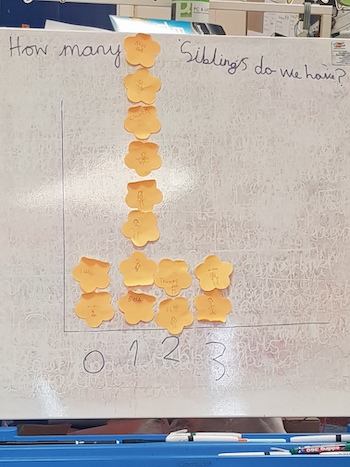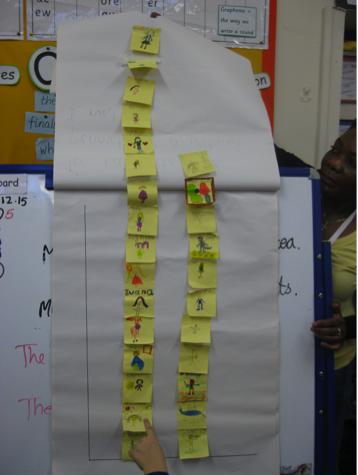Or search by topic
Number and algebra
Geometry and measure
Probability and statistics
Working mathematically
Advanced mathematics
For younger learners
Sticky Data



- Problem
- Getting Started
- Student Solutions
- Teachers' Resources
Children from South Darley CE Primary School collected 'sticky data'. They sent these photos:


Nicholas wrote about what they did:
We got our sticky notes and then we had to write our name (and picture) and then we had to stick it to the whiteboard.
There is one more boy and also there are 7 boys and 6 girls, and we also did how many siblings we have altogether - 18.
Thank you South Darley!
We also had a good response from Priorslee Primary Academy. Here are their submissions:
Emie, Amran and Jessica wrote:
How many boys and girls are there? There are 16 boys and 13 girls.
Which month has the most birthdays in your group? February, August and October
How old are the children in your group? 10 and 9
Niamh, Manieka, Lydia and Priya wrote:
Firstly, we counted the amount of children in the class and found out that there are 17 boys and 13 girls (not including the teacher). This makes 30 children and one teacher (31 people).
The next thing to do was to ask all the children in the class (including the teacher) what month they were born in, and how old they were. We also asked our teacher what month she was born in and her age.
The next thing we did was we wrote all of the months in the year and the number of children in that month on squared paper. We got three people in January, February, March, April, August and September. In May and July we found that there was one person in each month. In November there was no one, in December there were two people, in June there were four people and
finally with the most people was October with five people (including our teacher Mrs Johnston).
We also found out that nearly all the class are 10. There are 25 people that are 10, and 5 people that are 9.
Marley and Arjan wrote
We worked in a group of two and got post-it notes and asked the entire class for their name and the month they were born in. Once we got the answer, we put it in a bar chart to answer the questions.
1.9-10
2. October
3. 16 boys 13 girls
How many people were born in each Month.
Jan 3; Feb 4; Mar3; Apr 3; May3; Jun3; Jul1; Aug2; Sep1; Oct0; Nov0; Dec1
Amran, Emie and Jessica wrote:
We worked as a group of three but did the whole class. We gave each member of the class a sticky note and asked them to write their name and the month they were born. We then calculated each answer to the following questions that were given. Then we sorted each answer into a graph. Here is part of what we found out:
January: 2 girls and 1 boy
February: 1 girl and 3 boys
March: 1 girl and 2 boys
April: 0 girls and 2 boys
May: 1 girl and 0 boys
June: 2 girls and 1 boy
July: 1 girl and 0 boy
August: 2 girls and 2 boys
September: 2 girls and 0 boys
October: 1 girls and 3 boys
November: 0 girls and 0 boys
December: 0 girls and 2 boys
We then calculated each person's age and how many girls were a certain age and how many boys were a certain age.
3 girls are 9
10 girls are 10
14 boys are 10
2 boys are 9
Libby, Jada-Mia, Neha and Fatima sent in a graph showing their birthdays
Thanks to all of you at Priorslee
From Tiger Class via their teacher at Alexandra Primary School we were sent
My Year 3 class got stuck into Sticky Data today. We created a bar chart to answer the question:
How many girls and boys are there in Tiger Class? We could see clearly, when we had finished, that there were 16 girls and 11 boys in class that day.

Then we discussed what else we could show using our 'sticky' bar charts. We decided on:
Which month do the Tiger Class children have their birthdays? We had great fun making the bar chart and we had a good discussion afterwards. The children told me that I hadn't labelled it correctly as I hadn't left enough room for all the months on the X-axis. This made it difficult to read. We also hadn't left any room between the bars which also made it
more difficult to read.
At the end of the lesson, we had a good discussion about why we use bar charts and how they make it easier to show information quickly in a way that we understand.
We'd love to see what other bar charts children have created!
Thank you all, we've collected quite a few examples of your sticky data, but keep sending your ideas in!

